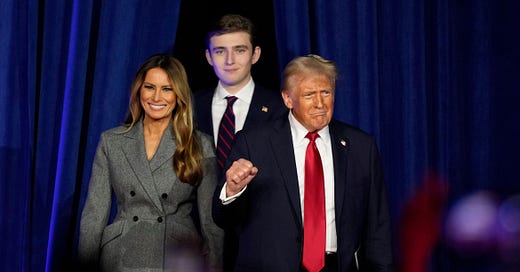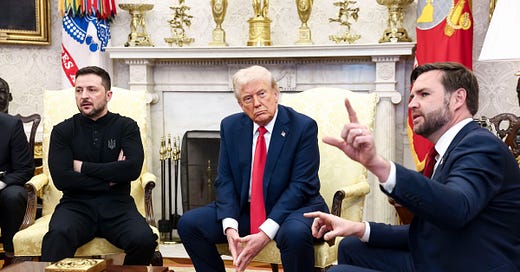
Diana’s death and the strange week Britain came apart
Iain Martin’s weekly newsletter, exclusive for Reaction subscribers
The only media outlet to use proper film to record the wedding of Diana Spencer and the Prince of Wales, and the processions through London on that day in July 1981, was Movietone News. The footage – restored recently in 4K – was re-released last week by AP, and it is worth watching. Film bestows a power and richness lacking in the day-glo cheap video used by TV teams who back then were learning how to use relatively new and more mobile cameras. Film seems to denote seriousness. Here is History, filmed respectfully to look like history with a capital H, seeming more enduring than the endless disposable video of today spewed out for 24 hour TV news and cut into a trillion social media clips to be taken out of context and shared virally in a demented manner.
The footage of Winston’s Churchill’s funeral – watchable in full at the Cabinet War Rooms museum in London – is similarly arresting on film. As with the 1981 royal wedding, the service took place at St Paul’s. Those two events – de Gaulle in one, and Thatcher in the other – might be thought to have taken place in different worlds or centuries, but they happened only 16 years apart.
Sixteen years after the Charles and Di “fairytale” in 1981 the bride was killed not wearing a seatbelt, traveling in a car driven by a chauffeur over the limit pursued by photographers. From Churchill to the death of New Labour’s “People’s Princess,” that’s just thirty two years, taking in a wedding, two cathedrals and a pair of funerals.
Incidentally, if scumbag press photographers had ever dared chase Churchill’s car through the Paris streets he would probably have stopped the driver and ordered his police guard to arrest or thrash the snappers. But by the late 1990s the tabloid and paparazzi culture, of snatched pictures and high speed pursuit of a still relatively young woman simply driving around of a Saturday evening, was so embedded that the denouement being a fatal crash was shocking when it came, if not particularly surprising.
This week Diana’s death has come back round again. There has been much media attention concentrated on the 20th anniversary of an event that remains as potent in terms of Western imagery and global impact as the sinking of the Titanic or the assassination of President Kennedy.
These anniversaries must be difficult for her sons, and for those friends who were genuinely close to her. This was a tragic event in which two young boys lost their mother, but contrary to the predications and hopes of those who hate their father, their relationship with Charles was strong and grew stronger in the aftermath. Both her sons pursued military careers and have a strong sense of duty. Neither became a yoga teacher in India or dropped out of life to emote full time. They both have an instinct for charity and duty, but that surely is influenced as much by their father’s extraordinary work with the Prince’s Trust as it is by their mother’s capacity for empathy and charitable activity. They’re a blend.
Nonetheless, the anniversary must have been a difficult moment for two still relatively young men who lost their mother. The 20th anniversary is also a public event and their mother is deemed public property. That means it came accompanied on the airwaves with a reheated rerun of the extraordinary and hysterical rubbish said 20 years ago this week, which personally speaking, I count as without doubt the worst week of my lifetime to be British.
It is difficult to describe clearly what happened that week in September 1997. Ian Jack’s famous essay for Granta, involving interviews with dissenters, probably came closest to nailing the madness.
Build it and they will come is a good description of what the media did. Round the clock TV news was relatively new and with all that airtime to fill there was nothing more to do than vox-pop people asking them how they felt. Footage of a few people laying flowers gave more people the idea. A trickle became a flood.
The tabloid newspapers were in an exposed position, but cunning. As Alwyn Turner recounts in his history of the 1990s – A Classless Society – that Sunday the newspapers (which went to print before the crash) contained horrible commentary about Diana, dismissing her as stupid and a public menace because of her cavortings with Dodi in the south of France. They also knew that the story of her death in a crash risked becoming about media misbehaviour and press regulation, so they needed to turn it away from the question of “papped” pictures. The stiff upper lip Queen and her son were the perfect targets.
In this way, a caring mob that supposedly mourned Diane for her ability to care, feel, empathise within days demanded that her two sons, initially in the best possible place resting in peace and quiet with their loving grandparents at Balmoral away from the press, had to be flown to London ahead of the funeral to be paraded in front of the piles of rotting flowers laid in her memory. Show us you care, Ma’am, by putting two grieving young boys out there to be touched by the weeping mob. Give me strength.
Competitive grief was the name of the game and the politicians were utterly shameless. In pandering to this even the Presbyterian son of the manse Gordon Brown was almost as bad as Tony – pass me a peeling onion – Blair. Brown wanted a bank holiday for “Diana Day”. On the Sunday, BBC Radio 1 played only slow songs. There was nothing else allowed on the television. The reaction was out of all proportion to the event. Daft claims about a supposedly united nation were made and dissent stifled or shouted down.
And there it was again this week, in the coverage even from some usually sensible outlets. For those of us who did not submit to the media and public madness the week that Diana died it was like briefly going back in time to hear it said this week on numerous BBC programmes that in September 1997 Britain had been “united in grief” or “mourning”.
That was not the case. We were rather divided, not united. Go to many a social gathering or work that week or the week after and it was like being a member of a resistance group looking for allies. “What an extraordinary business…” one said, looking for any clue in the face of another that they had not been consumed by mawkish melancholy. Then, blessed recognition. “Oh, thank goodness, I thought it was just me.” “And me,” added another. And so on.
Hypocrisy has rarely required quite so many pages of newsprint. The hacks who put out our massive and best-selling funeral specials (I was on Scotland on Sunday back then) put it together knowing there was more hokum per square half foot on those pages than at any time since the penny dreadfuls mined Victorian melodrama to get the readers weeping.
I know. What’s new? Diana week was a game of mass manipulation for sales, which required an expert tapping into the vulgar spirit of that week and picture after picture of all those outfits, and weeping pop stars weeping on cue. Fine, that’s popular newspapers and popular culture in the middle of a major event but surely we can twenty years on not give the downright wrong impression to those too young to remember that period. The nation somehow felt as one? Why lie? Why twist history?
I am grateful to Stephen Tall, who pointed out this week that the research carried out by the BBC and published in 1998 after the fuss had died down found that 44% – not a kick in the backside off half – of Britons thought the coverage was alienating and too emotional. There were tens of millions of us thinking throughout it was somewhat sad but hardly the end of the world.
But there was much more to it than media manipulation, of course. Princess Diana was a complex character (volatile, emotional, with a gift for media) and someone who hastened a shift in British society towards a less restrained outlook. For more than a decade she was the focal point for the abused, the overlooked, the divorced woman treated unfairly, the marginalised and even for a solid middle England that respected the monarchy but had had enough of being patronised by the stuffed shirts.
The depth of what was tapped into in terms of anti-establishment spirit only becomes properly apparent now, in the light of a slew of scandals that have emerged in the last two decades in the police, in the criminal justice system and in the care system. Diana had shown to her fans that you couldn’t even – it seemed – trust the Queen Mother. What then? Who could you trust? What else was really going on everywhere, in our midst?
One of the oddest aspects of the Britain of my childhood (which in my case was exceedingly happy) was the excessive trust placed in authority. Was it a legacy of the War and following orders? Or the delineations of the class system? Whatever the reason, blind trust of adults in mid-level leadership positions was the default position. Mix this with the sexual revolution and excessive license, and mingle it with the naughty postcard tradition of titillation magnified and updated on screen in Carry On films and so on, and you end up with the vile Jimmy Savile.
Ironically, Savile was an early pioneer in the 1980s and 1990s of the media’s empathy industry, doing a lot of work for charity and talking about it endlessly as a cover for abuse. It was in this weird climate that Diana instinctively offered an outlet for a lot of unhappy people, others who wanted to join in shown how to by the media, and some others who just felt the British needed to be less traditionally British about grief.
What in the end accorded Diana such a powerful legacy is that she won the culture war, albeit with the Windsors adapting themselves cleverly out of trouble by using Blair, who thought he was using them. Where is Tony Blair now? A ruined figure. The Queen? A magnificent and loved figure. Charles? Married to Camilla.
Beyond that Diana was a hugely disruptive political force, even if she never meant to be, not just because displaying emotion became a vital requirement for any leader. Look what happened to Theresa May when she couldn’t and Corbyn could. More significantly, Diana cut across traditional demographic demarcation lines and made allies out of disparate groups – that is minorities, radicals that wanted the monarchy brought down, Daily Mail middle England, and women who had had enough of men thinking the world was set up for the convenience of men. This applied on the other side too. High Tories, liberal rationalists, women who didn’t like the weeping but pampered Princess schtick, and the middle class left, were brought together in thinking that the country had gone utterly mad and abandoned reason in Diana week.
Britain came apart that week. When we look at the state of British politics now – with the strange alliances for Brexit and against, and the way the confused traditional parties are struggling to work out which way up to hold the electoral map – it can be traced in part to a car crash in a tunnel in Paris and the bizarre aftermath.









